Sometimes there are fabrics that deserve the time it takes to pattern match. For me centre front and centre back seams are essential for pattern matching (if possible) especially when using large, bold designs.
You will need more fabric to do this as you will need to move the pattern pieces around on the fabric to find the perfect match.
Here's a run down on how to pattern match...
1. Cut each pattern piece individually. Begin by marking your stitching line on the pattern piece along the seam that you want to pattern match.

2. Cut just one side of the pattern out of fabric.

3. Mark the stitching line on the fabric pattern piece that you have just cut. I used a Sewline Duo Marker to mark mine.

4. Fold the seam allowance back along this line. Press along this line.

5. Move this fabric pattern piece with seam allowance folded back around on your remaining fabric until it matches with the design. The black line shows the join.

6. Draw a line on the piece of fabric that still need to be cut where the pattern meets and matches. This will be the stitching line.

7. Fold back the seam allowance on the pattern piece. Then flip the pattern piece so that it is a mirrored version of the first pattern piece. Lay the mirrored pattern piece on the marked stitching line. Check the pattern match exactly across the two pattern pieces. Pin the pattern piece to your fabric folding the seam allowance out flat before cutting.


8. Cut the second piece out.

9. Pin and sew the seam. Sewline glue is great for keeping everything in place. Glue the seam before sewing so that it doesn’t shift when you are sewing.

